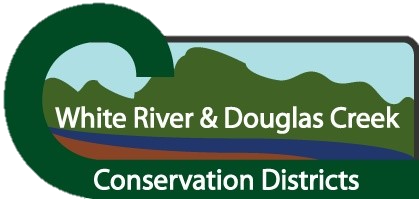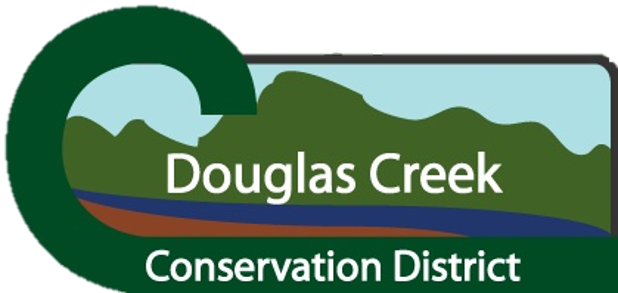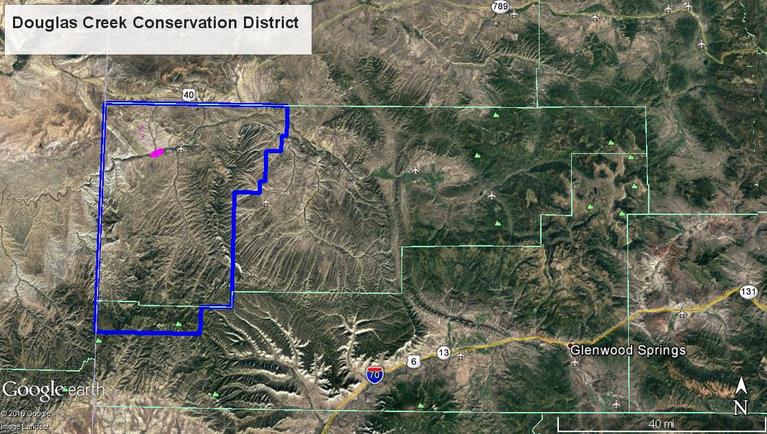Monthly Board Meetings
- First Tuesday of each month
- 6:00 p.m.
- Rio Blanco Water Conservancy District Building (2252 E Main St., Rangely, CO, 81648)
- President: Bill Hume
- Vice President: Rosaly Coombs
- Secretary/Treasurer: Scott Robertson
- Supervisor: Ron Reich
Important Info about the Douglas Creek Conservation District
Conservation Districts are political subdivisions of the State of Colorado –The authorities; powers and structure are contained in Colorado Revised Statutes, Title 35, Article 70.
To make available technical, financial and educational resources, whatever their source, and focus or coordinate them so that they meet the needs of the local land manager with conservation of soil, water and related natural resources.
To provide guidance and technical assistance to encourage and promote the wise use of all the natural resources within the district by private landowners and government land management agencies.
Natural Resource Data (needs updated)
asdf
Trends Impacting Conservation in DCCD (needs updated)
Regulations such as: Endangered Species Act (ESA), Equal Access to Justice Act (EAJA), Wild Free-Roaming Horse and Burro Act (WFRHBA), and the Clean Water Act (CWA), etc. are making it more and more difficult to wisely utilize our natural resources while protecting the environment. Private property rights are being more and more limited by the agencies’ regulations and acts of Congress.
Continually increasing demands on our public and private lands in addition to the arid climate and short growing seasons are creating the critical need for better management of the lands.
The public lands in the district are predominately BLM. Local, state, and federal budgets are exceptionally tight and we will all need to work together and prioritize in order to address the most critical natural resources.
Approximately 4 million acres of Colorado forests have been killed by mountain pine beetles and spruce beetles since 1996. Forests within Rio Blanco County have been heavily impacted. Devastating forest die-offs have affected watershed health through excessively hot fires in beetle killed timber that sterilizes the soils. Forest management significantly impacts soil, water, air, plant, animal (SWAPA) health. Therefore, proactive forest management is essential for the health of our watersheds.
Wild horse numbers increase at 20% per year. As of 2013, BLM made the decision to stop removing excess horses from the range due to meeting the maximum number in the holding facilities at 50,000 excess horses and an annual budget of $46 million to warehouse these excess horses. Therefore the rangelands will be even more significantly degraded due to excess horses on the range.
While Rio Blanco County is well known as one of the best deer and elk hunting areas in the country, the deer and elk numbers are declining. The Colorado Parks and Wildlife (CPW) indicate the decreasing elk populations are by design through increased harvest. The declining deer populations are due to poor fawn survival and recruitment. Many locals believe the poor fawn survival is due to predators.
Below are the 2011 & 2012 population estimates as provided by the CPW:
Mule Deer
- 2011: 50,000 – 55,000
- 2012: 45,000 – 50,000
Elk
- 2011: 40,000 – 45,000
- 2012: 37,000 – 42,000
Prioritized Natural Resource Issues & Goals (needs updated)
Utilize our Land and Natural Resources Plan and Policies to to help guide local, state, and national land use and policy decisions.
Rangeland health – must be managed for multiple uses and for watershed health
Wildlife – Misuse of the Endangered Species Act is causing single species management on public and private lands while not actually protecting the species; private landowners and local entities working together are more successful at protecting all species in a balanced and scientific approach. Therefore, the District will work to improve local participation in decision making processes.
Water – “life blood” for the human race via water quality for drinking and quantity for food and fiber production. Water rights are the backbone of the agriculture industry feeding this world. Therefore, the District will actively inform and educate the public and decision makers about the need to continue the Prior Appropriations Doctrine that has served this state well and will continue to do so. We oppose the federal government acquiring water rights.
Reclamation – decrease impacts from surface disturbance, work with energy companies to improve reclamation for sustainability
Natural Resource Information /Education Priorities & Goals (needs updated)
- Provide accurate and timely information regarding the wise use of our natural resources.
- Develop an attractive and easily accessible website with natural resource information
- Develop and utilize a Resource Plan in all our communications.
- Provide written comments and oral testimony on natural resource issues affecting our District
- Publish quarterly newsletter to landowners
- Publish articles and letters to the editor in local and regional newspapers
- Develop and air TV informational spots regarding natural resources and public lands management issues
- Provide interviews on radio stations regarding natural resources and public lands management issues
- Present natural resource presentations regarding natural resources and public lands management issues
Youth Education (needs updated)
asdf


